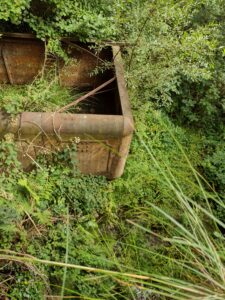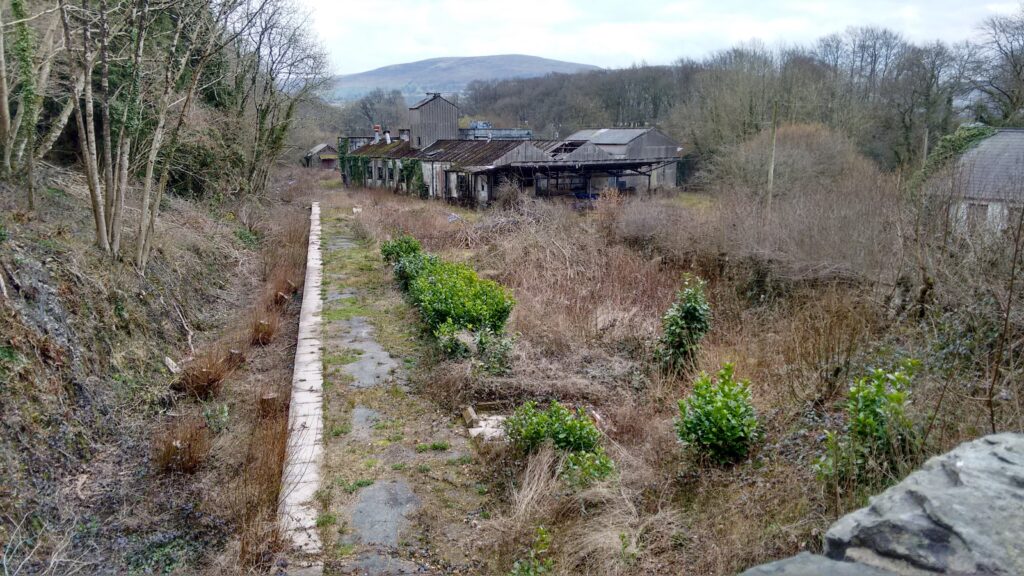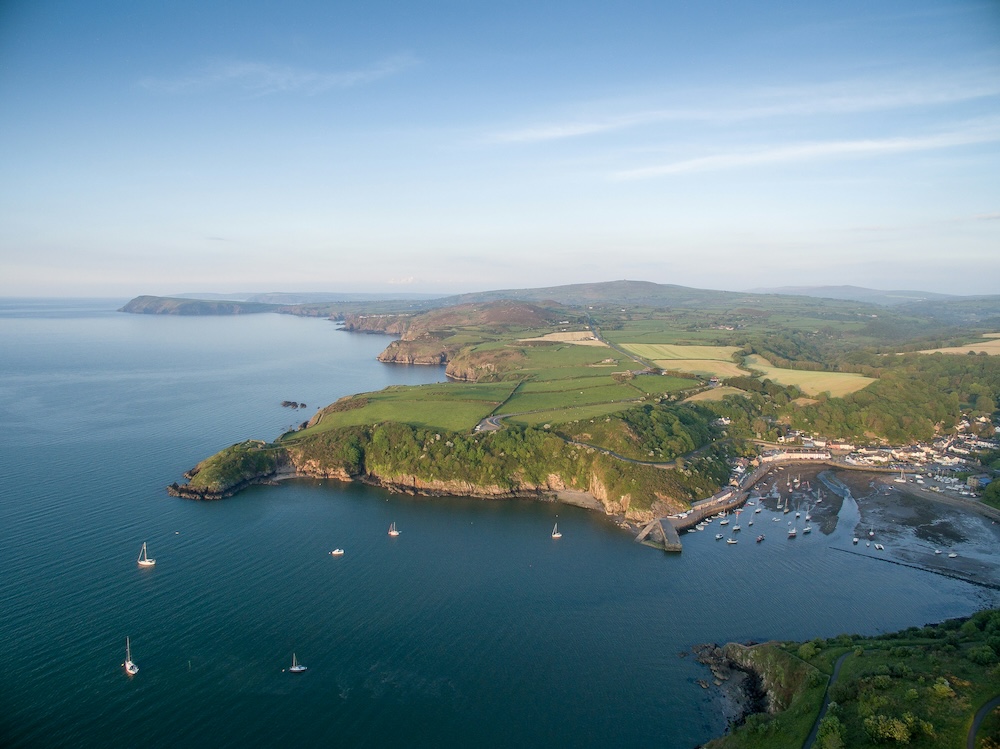Reflecting on Tregaron and its closed railway, Jasmine Donahaye explores the value judgements lurking in questions of distance and access.
Last week, in the Eisteddfod car park, I overheard two men discussing the festival’s location; one remarked that Aberystwyth was special because it was ‘cut off’, and that Tregaron was ‘remote’, and of course had no train service.
As always, I found myself thinking about what this word ‘remote’ means. Remote from what, from whom? For whom? And what is the antonym of remote? Certainly not ‘near’, or ‘close’. When my older daughter lived just north of San Francisco, her location was distant from me, but not remote. Now she lives at the end of a dirt road in a national forest near the border with Oregon. The journey from the airport by train takes nine hours; there’s one train per day, which stops in the nearest town, but there’s no public transport from the station to where she lives. In terms of miles, she is no further away from me than she was before, but she is now considerably more remote – because ‘remote’ is a social value, not a geographical measurement. It is not to do with distance, but accessibility – specifically accessibility from an urban centre.
It’s suggestive that no one uses the noun ‘locals’ when talking about the opinions or experiences of urban inhabitants.
There are other value judgements or assumptions in the use of the word ‘remote’, sometimes implicit, often explicit. Remote by extension can mean quiet, slow to change, behind the times, primitive, conservative – but it can also mean a relief from the human intensity of urban life, a place for getting in touch with nature, which is to say getting in touch with yourself (nothing puts you in touch with yourself quite so effectively as an unseen ewe coughing suddenly in the dark like some tubercular lurker).
Related to the value judgements in the word ‘remote’ are the value judgements in the use of the word ‘local’. It’s suggestive that no one uses the noun ‘locals’ when talking about the opinions or experiences of urban inhabitants. According to reporting in the media, ‘locals’ are always elsewhere and slightly other; by default, ‘here’ is urban.
By these measures, the man in the car park was right: Tregaron is remote. And just to reinforce what that means, the penumbra of unexamined values was put rather succinctly by S4C presenter Maggi Noggi, who, in an interview with the BBC, asserted the importance of the Eisteddfod’s representation of diversity in Tregaron, ‘because there are people in deepest, darkest, rural Wales who might never come across queer people or people of colour, or people who are different until they come here and they see them.’ Deepest, darkest, rural Wales, with its isolated, unworldly, local yokels? Perhaps, conversely, holding the Eisteddfod in Tregaron might have helped bring the rest of the population up to date about the reality of Welsh rural life.
That reality, is, of course, shaped by its remoteness, meaning its inaccessibility from densely populated areas. Its very inaccessibility is what keeps it sparsely populated. The desire of rural people for increased access to urban centres comes at a cost that we rarely consider when we complain about poor public transport or higher food and petrol prices, and outrageous ‘out of area’ delivery fees – because accessibility doesn’t only work in one direction.
***
I live on the main road between Aberystwyth and Tregaron, and all the Eisteddfod traffic from the northwest and the west has been routed past my house. It’s a rural road that usually has a steady stream of rush-hour cars, but otherwise the traffic is fairly light. There’s a bus every two hours between 8 a.m. and 6 p.m., and there are plenty of tractors, sheep trailers, and goods vehicles servicing the farms. The busiest time is during the silage season, when heavy agricultural traffic tears up and down the road for days.
Innovative. Informed. Independent.
Your support can help us make Wales better.
Prior to the start of the Eisteddfod, large vehicles with heavy loads of festival infrastructure negotiated some very squeaky narrows and bends. Then a steady stream of caravans began to build, and on Friday there was the first big passage of cars. As the weather improved, the traffic got heavier each day and lasted longer; the direct buses laid on from Aberystwyth hardly put a dent in it. On the second Friday night, departing traffic lasted till 3 a.m., and on Sunday the exodus went on long into the afternoon.
Inevitably, the relative inaccessibility of the Eisteddfod in Tregaron has highlighted the closed railway line between Carmarthen and Aberystwyth, and all this traffic points to the cost of that gap.
Evidence of the infrastructure of the closed line remains almost everywhere along its route. Sometimes it’s only noticeable if you know you’re looking at it, and sometimes it’s as highly visible as the older industrial remnants in the Ceredigion landscape, which are often only preserved by neglect rather than by conservation effort. Some stretches, such as at Cors Caron or along the River Ystwyth, are important conservation areas, but inaccessible parts of the closed line, which, in places, is dense woodland, are equally valuable as wildlife habitat.

At Pont Llanio, south of Tregaron, that combination of wildlife habitat and industrial remnants is particularly poignant. When trees are in leaf a lot of it is obscured. But in winter, if you stand on the bridge over the line, you can see the old creamery buildings and much of the intact station infrastructure, left over from when this bit of the working railway was closed, finally, in 1970. Even the raised water tank remains, rusty but whole, from the late days of steam, which ended here in 1964. You can make out the same shape of the platforms at Llanilar, if you look for them. A little further along, at Trawscoed, the rail bridge across the main road is gone, but the embankment remains, as does a second bridge. Where the road crosses the railway cutting just south of Trawscoed it’s all damp shadowy untouched woodland, a haven for mammals and birds, perfect territory for rapidly decreasing species such as willow tits, like a great deal of so-called wasteland.
The short-term loss of some of that habitat to a new railway line would be grievous, but the longer-term gain of reduced road traffic, particularly if it included heavy freight, would surely counterbalance that damage. How much use could the reopened railway get, though, given the sparse population of its surroundings? It wouldn’t be a major commuter line to an urban centre, like the reinstated route from Tweedbank to Edinburgh, with which the proposal to reopen it sometimes gets unfavourably compared. The rail campaign group, Traws Link Cymru, addresses such questions and objections compellingly in its published materials. It argues for the primacy of more qualitative factors than a consideration of population density, factors that nonetheless have measurable, costable impacts – such as environmental safeguarding for future generations, and the interconnectedness and viability of these sparsely populated communities scattered in and around the rural towns of Ceredigion and Carmarthenshire. Its arguments have been convincing enough that there are now promising prospects of the project going ahead.
At a personal level, reflecting on this as thousands of cars and caravans drive home from the Eisteddfod past my house, I have my niggling doubts. It’s the disconcerting reverse of access to urban centres that troubles me. I think of the man I overheard, characterising Aberystwyth and Tregaron as remote. The railway would change these towns and their hinterland of villages, hamlets, and scattered houses in ways that we might want, but it will also change things in ways we cannot anticipate. Perhaps we should be careful what we wish for.
Jasmine Donahaye is the IWA’s writer in residence at the Eisteddfod. To read her first article, click here.
All articles published on the welsh agenda are subject to IWA’s disclaimer.





